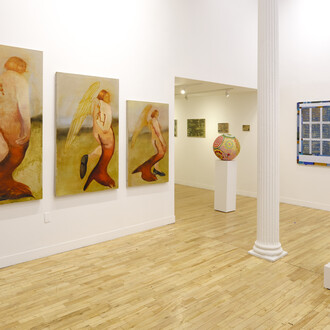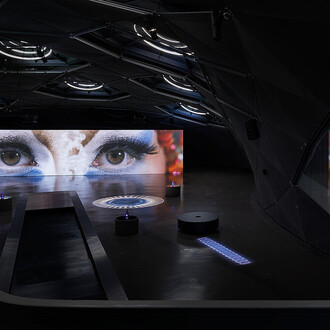Ileana Sonnabend was one of the greatest and most influential discoverers of artistic talent of the late 20th century, known and appreciated for her intuition, strength of character, ground-breaking vision and for that eclecticism of taste and thinking that enabled her to understand and promote all that was new in American and European art.
Created over many years and a material reflection of her commitment to supporting young artists and the avant-garde movements of the 20th century, her extraordinary collection now finds a “European home” in the splendid monumental rooms on the second floor of the Galleria Internazionale d’Arte Moderna at Ca’ Pesaro.
The exhibition marks the first step in a long-term collaboration with the Sonnabend Collection and Sonnabend Collection Foundation, and offers an extraordinary opportunity to enrich the city’s 20th-century art collections and the permanent displays at Ca’ Pesaro, which thanks to the works from the Ileana Sonnabend collection, will be able to offer its visitors a more comprehensive itinerary with plenty of masterpieces from the history of art of the whole of the 20th century.
The Sonnabend Collection picks up exactly at the point in which Ca’ Pesaro ended its collecting spree and relationship with the Biennale, and will lead the visitor past a series of works of the highest artistic quality forming part of the principal experimental schools of the late 20th century through over 70 iconic works of the period.
The exhibition, based on a project by Antonio Homem and Nina Sundell, with the scientific direction of Gabriella Belli and the precious collaboration of the Sonnabend Collection and the Sonnabend Collection Foundation, will show us the main directions adopted by contemporary art in the late 20th century - from Neo-Dada to Pop Art, Minimalism to Arte Povera, Conceptual art to Neo-Expressionism and on to contemporary photography – with the same self-confidence and “consistent yet light” approach as was adopted by Ileana Sonnabend in her exploration of all the post-war art movements, and governed her personal and autonomous choice of art.
Thanks to her passion and the splendid partnership with her first husband, Leo Castelli, and with her second, Michael Sonnabend, the Hungarian Ileana Schapira – born in Bucharest in 1914, collector, gallery-owner and mentor to many artists – supported and promoted American art in Europe and European art in America with a pioneering spirit.
The galleries she opened with Leo Castelli in Paris in 1939 and in New York in 1957 – where she began exhibiting the works of Jasper Johns and Robert Rauschenberg – and those opened in later years with Michael Sonnabend in Paris in 1962 and in New York in 1970, became fundamental points of reference for all those wanting to see and learn about the latest art. They were absolute outposts of modernity.
In the exhibition, the visitor will be able to admire such well-known masterpieces as Jasper Johns’ Figure 8 of 1959, and Interior (Combine painting) of 1956, Payload (1962) and Kite (1963) by Robert Rauschenberg, whom Ileana, together with Leo Castelli and Alan Solomon, helped to bring to the Biennale di Venezia in 1964, where he won the Grand Prix for Painting. This proved a crucial event for his career, for the history of the International Art Exhibition in Venice and for contemporary art generally.
Alongside these masters, there will also be the great exponents of the various forms of Pop Art, which Ileana Sonnabend helped discover well before current categories were drawn up; the link with Abstract Expressionism in the form of Jim Dine will be on show with two fine works, together with Claes Oldenburg and his amusing Roast Beef of 1961, as will be the current associated with the media culture, with Roy Lichtenstein, whose Little Aloha (1962) will also be on display. And there will be James Rosenquist with Balcony of 1961, Tom Wesselman with Still life #45 and Seascape #14 and, above all, Andy Warhol, with an incredible group of eight works, including Nine Jackies (1964), Triple Rauschenberg and Campbell’s Soup Can (Turkey Noodle), both of 1962.
Other artists on show include Jeff Koons, who makes use of fetish objects of everyday consumption and constructs sculptures with gadgets of various brands, Haim Steinbach and Richard Artschwager, who, 20 years later, made use of 1960s Pop Art and its exponents, and here their works may be compared with their sources of inspiration.
Between the late 1960s and early 1970s, Ileana also exhibited the work of some young Italian artists, starting with Mario Schifano and continuing with Gilberto Zorio, Mario Merz, Giovanni Anselmo, Pierpaolo Calzolari and Jannis Kounellis, together with Paolini and Pistoletto, all of whom are represented by a selection of works from the Sonnabend Collection at Ca’ Pesaro, as are the new realists, Arman and Christo.
Minimal Art, Arte Povera, Conceptual Art and Narrative Art, which explore the new possibilities of language through the use of non-pictorial materials and a new concept of space and setting no longer circumscribed by the picture or sculpture, are also amply documented with such artists as Nauman, Serra, Morris and Sonnier. Ileana was way ahead of her time in sensing the innovative force, unique personality of many other artists too, thereby helping to establish them on an international footing.
A sizeable number of European artists began to exhibit in the New York gallery during the 1970s, such as Gilbert & George, Christian Boltanski, Anne and Patrick Poirier. In the early 1980s, Ileana’s curiosity turned to the “renewal of painting” urged by young German and American artists and A.R. Penck in particular – one of his large, powerful schematic figure paintings, Verteidigung (1982), “ a sort of mythical and primitive scene”, will be in the show – together with Jorg Immendorff, whose Ewiges Braunhemd of 1983 is included, Anselm Kiefer with Baum mit Palette (1978) and Rona Pondick with her sculpture Dog (1998-2001).
This same period saw Ileana develop an interest in photography, thanks in part to her contacts with a number of major artists who were particularly interested in the medium for their own production of Minimal Art with regard to their research in the fields of linguistics, semantics and formal logic, such as Vito Acconci, Barry LeVa, William Wegman; this interest in photographic art works continued into more recent years with Hiroshi Sugimoto, Clifford Ross, Andrea Robbins e Max Becher, Candida Höfer, Lawrence Beck and Elger Esser, all of whom are present in the collection with works of especially high quality.
The exhibition closes with a large selection dedicated to Minimal Art, one of Ileana’s apparently contrasting passions, and includes some major works from the 1960s by the movements founding figures: Donald Judd, Dan Flavin, Robert Morris with their sculptures, composed of elementary geometric, single or repeated forms, made with preferably industrial materials.
Alongside these are other works by those artists who in later years revived and developed the ideas first expressed with the Minimalist movement: Sol LeWitt, towards whom Minimal Art is heavily indebted as regards the theoretical aspects, together with Peter Halley, Mel Bochner, John McCracken, Larry Bell, Clay Ketter: a way to recall that Ileana always remained faithful to her vocation of providing support for young artists and the renewal of critical ideas.
Ca’ Pesaro - Galleria Internazionale d’Arte Moderna
Santa Croce, 2076
Venice 12312 Italia
Ph. 848082000 (from Italy)
Ph. +3904142730892 (from abroad)
info@fmcvenezia.it
capesaro.visitmuve.it
Opening hours
From April 1st to October 10am – 6pm (ticket office 10am – 5pm)
From November 1st to March 31st 10am – 5pm (ticket office 10am – 4pm)
Closed on Monday
Tickets
Full price 10,00 €
Reduced price 7,50 €











